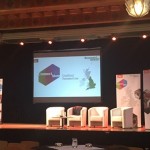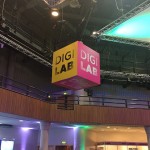 I recently attended the Jisc Connect More event in Sheffield, which focused on digital capabilities in higher and further education.
I recently attended the Jisc Connect More event in Sheffield, which focused on digital capabilities in higher and further education.
Digital Capabilities can be defined as the skills and/or competencies required for living, learning and working in a digital society.” (Jisc, 2015).
Before becoming a TEL assistant, I worked as a School Administrator in an environment where everyone strived to share good practices. This is exactly what I found at Jisc Connect More. Everyone was engaging, collaborating and sharing good practices. There were also breakout sessions that gave plenty of opportunities to workshop ideas and concepts.
The opening keynote by John Hill from the University of Derby was about how their institution use their TEL strategy to push digital capabilities across the institution and prepare staff and students to be digitally ready. Enhancing digital skills for all students and bringing digital capabilities into job profiles were some of the aspects the keynote highlighted. The University of Derby have also brought in Student Digital Champions to help promote the use of digital resources and digital spaces across the University.
One thing I have taken away from the keynote and the day itself is how necessary it is for students to gain digital skills in order to enter the workplace. One interesting finding in the Jisc digital student tracker 2017 was that while over 81.5% of Higher Education learners feel that digital skills will be important in their chosen career, only 50% agree that their course prepares them well for the digital workplace.
Building a Digital Environment to Support Students’ Digital Capabilities
We explored this further in the first breakout session of the day, which was called Building a Digital Environment to Support Students’ Digital Capabilities. In our group, we felt it was important to ask students how they want to engage with using digital tools etc and recognised that we should not assume students have the digital knowledge and skills when they first arrive at University. We also discussed digital accessibility and digital inclusivity and how this should be included when building a digital environment to support students’ digital capabilities.

As part of the workshop, we were asked the question ‘How do we assess students’ digital capabilities at our own institution?’ As a TEL newbie I wasn’t able to fully answer this question, but I would be interested in hearing how your School or courses assess students’ digital capabilities. Are these courses part of the curriculum or more for Continuing Professional Development purposes? If you are happy to share your practices, please comment below or email Tel@yorksj.ac.uk
Curriculum Confidence: Designing for Digital Capabilities in the Curriculum
The next breakout session I attended was called Curriculum Confidence: Designing for Digital Capabilities in the Curriculum. During the session, we were asked to share examples of good digital practices from our own institution. We used the digital capability activity cards to write down our ideas. Our group discussed how distance and/or traditional learners could use Google Docs/Sites to collaboratively research and write up a topic.
You can find other examples from the activity on the Designing for Digital Capabilities in the Curriculum blog post by Scott Hibberson from Jisc. You will also find lots of other resources on this blog, which will help identify areas where digital practices can be embedded into the curriculum, including the Digital Capability Curriculum Mapping document.
We also looked at the Jisc NUS benchmarking tool which is a resource that looks at improving the student digital experience at HE institutions. I found this resource really interesting and it could help to integrate digital into curriculum design and/or other aspects of university life in future.
Techniques for Digital Creation, Problem Solving and Innovation
The final breakout session I attended was called Techniques for Digital Creation, Problem Solving and Innovation where we were given the opportunity to use the Co-Design playdeck to look at different scenarios. Co-design is a collaborative design process where end users and various stakeholders work together to explore new ideas and develop solutions. The playdeck cards are divided into three categories: Understand, Imagine and Build.
Our group looked at designing a digital skills training programme that staff could value. We only managed to touch on a couple of points in the playdeck, which focused on learning from other users and sharing ideas and good practices but I would be interested in using these cards in future to develop innovative solutions.
Panel Discussion
At the end of the day there was a panel discussion with John Hill, Scott Hayden and Vicki McGarvey, facilitated by Sarah Davies from Jisc. I found this really interesting as they discussed the idea of creating spaces where staff can learn and experiment before using new technology tools in their own courses. Again, being new to this role, I have discovered different kinds of technology that I didn’t know existed and will be sharing this knowledge with you once I have experimented.
DigiLab
 At the back of the room at Connect More, there was the DigiLab, where I could try out some of the new technology and apps that are currently in the marketplace. I had a play with SCIO, the world’s first pocket size molecular sensor, which reads the chemical make-up of materials using a no touch sensor.
At the back of the room at Connect More, there was the DigiLab, where I could try out some of the new technology and apps that are currently in the marketplace. I had a play with SCIO, the world’s first pocket size molecular sensor, which reads the chemical make-up of materials using a no touch sensor.
There was an opportunity to test out a full laboratory simulation in virtual reality. Unfortunately, I didn’t get to experiment with this, but I can see the benefits of using virtual reality in certain classroom situations.
I saw a demonstration of the AIPOLY app, which is a free app that uses artificial intelligence and helps people who are visually impaired to quickly identify objects using their smartphone. The last thing I experimented with in the DigiLab was Leap Motion.
Leap Motion connects to your computer or device, enabling you to control objects in ‘thin air’ using your hands as the sensors detect the motion. You can see this in the video below where I attempted to add robot heads to moving robots. How could Leap Motion be applied in learning and teaching? Please share your thoughts and ideas in the comments below.
Thank you @jisc for a really great event. Much to take back and reflect on from #connectmore17 Sheffield. I enjoyed attempting Leap Motion pic.twitter.com/J9cVxyU3qe
— Susanne Mills (@SuzyYSJ) 7 July 2017
You can access the PowerPoint slides from the Jisc Connect More website.
The #connectmore17 Twitter hashtag was used in discussions on the day and is worth taking a look.
If you have any questions or comments about any of the sessions I attended, or tools or technologies that I have mentioned, please use the comments below or contact TEL@yorksj.ac.uk
Suzy

0 responses on "Jisc Connect More 2017 - Reflections"